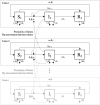Combining epidemiology and economics to assess control of a viral endemic animal disease: Porcine Reproductive and Respiratory Syndrome (PRRS)
- PMID: 36084100
- PMCID: PMC9462702
- DOI: 10.1371/journal.pone.0274382
Combining epidemiology and economics to assess control of a viral endemic animal disease: Porcine Reproductive and Respiratory Syndrome (PRRS)
Abstract
Porcine reproductive and respiratory syndrome (PRRS) is an extremely contagious disease that causes great damage to the U.S. pork industry. PRRS is not subject to official control in the U.S., but most producers adopt control strategies, including vaccination. However, the PRRS virus mutates frequently, facilitating its ability to infect even vaccinated animals. In this paper we analyze how increased vaccination on sow farms reduces PRRS losses and when vaccination is profitable. We develop a SIR model to simulate the spread of an outbreak between and within swine farms located in a region of Minnesota. Then, we estimate economic losses due to PRRS and calculate the benefits of vaccination. We find that increased vaccination of sow farms increases the private profitability of vaccination, and also transmits positive externalities to farms that do not vaccinate. Although vaccination reduces industry losses, a low to moderate vaccine efficacy implies that large PRRS losses remain, even on vaccinated farms. Our approach provides useful insight into the dynamics of an endemic animal disease and the benefits of different vaccination regimens.
Conflict of interest statement
The authors have declared that no competing interests exist.
Figures






Similar articles
-
Comparison of serum and oral fluid antibody responses after vaccination with a modified live (MLV) porcine reproductive and respiratory syndrome virus (PPRSV) vaccine in PRRS endemic farms.Trop Anim Health Prod. 2015 Oct;47(7):1337-42. doi: 10.1007/s11250-015-0868-6. Epub 2015 Jun 13. Trop Anim Health Prod. 2015. PMID: 26070293 Free PMC article.
-
Effect of vaccination with a porcine reproductive and respiratory syndrome subunit vaccine on sow reproductive performance in endemic farms.Vet Rec. 2018 May 26;182(21):602. doi: 10.1136/vr.104547. Epub 2018 Mar 15. Vet Rec. 2018. PMID: 29545353 Clinical Trial.
-
Evaluation of the effect of a porcine reproductive and respiratory syndrome (PRRS) modified-live virus vaccine on sow reproductive performance in endemic PRRS farms.Vet Microbiol. 2017 Sep;208:47-52. doi: 10.1016/j.vetmic.2017.07.016. Epub 2017 Jul 17. Vet Microbiol. 2017. PMID: 28888648
-
Review on the transmission porcine reproductive and respiratory syndrome virus between pigs and farms and impact on vaccination.Vet Res. 2016 Oct 28;47(1):108. doi: 10.1186/s13567-016-0391-4. Vet Res. 2016. PMID: 27793195 Free PMC article. Review.
-
Live porcine reproductive and respiratory syndrome virus vaccines: Current status and future direction.Vaccine. 2015 Aug 7;33(33):4069-80. doi: 10.1016/j.vaccine.2015.06.092. Epub 2015 Jul 4. Vaccine. 2015. PMID: 26148878 Review.
Cited by
-
Pigs lacking the SRCR5 domain of CD163 protein demonstrate heritable resistance to the PRRS virus and no changes in animal performance from birth to maturity.Front Genome Ed. 2024 Mar 13;6:1322012. doi: 10.3389/fgeed.2024.1322012. eCollection 2024. Front Genome Ed. 2024. PMID: 38544785 Free PMC article.
-
Predicting Potential PRRSV-2 Variant Emergence through Phylogenetic Inference.Transbound Emerg Dis. 2024 Feb 5;2024:7945955. doi: 10.1155/2024/7945955. eCollection 2024. Transbound Emerg Dis. 2024. PMID: 40303160 Free PMC article.
-
Changes in Saliva Analytes in Pigs in Different Clinical Situations from Farms Positive to Porcine Reproductive and Respiratory Syndrome (PRRS): A Pilot Study.Viruses. 2025 Jun 9;17(6):833. doi: 10.3390/v17060833. Viruses. 2025. PMID: 40573424 Free PMC article.
-
Dynamics of Feline Coronavirus and FIP: A Compartmental Modeling Approach.Vet Med Int. 2023 Nov 17;2023:2721907. doi: 10.1155/2023/2721907. eCollection 2023. Vet Med Int. 2023. PMID: 38023430 Free PMC article.
-
Formononetin and mizoribine inhibit Porcine Reproductive and Respiratory Syndrome Virus replication in vitro.Front Nutr. 2025 Mar 24;11:1501685. doi: 10.3389/fnut.2024.1501685. eCollection 2024. Front Nutr. 2025. PMID: 40196742 Free PMC article.
References
-
- Sumner DA. Exotic Pests and Diseases. Biology and Economics for Biosecurity. First. Ames, Iowa: Iowa State Press; 2003.
-
- Jarvis LS, Valdes-Donoso P. A Selective Review of the Economic Analysis of Animal Health Management. Journal of Agricultural Economics. 2015; 1–25. doi: 10.1111/1477-9552.12131 - DOI
-
- Hennessy DA. Behavioral Incentives, Equilibrium Endemic Disease, and Health Management Policy for Farmed Animals. American Journal of Agricultural Economics. 2007;89: 698–711. doi: 10.1111/j.1467-8276.2007.01001.x - DOI
-
- Perez AM, Davies PR, Goodell CK, Holtkamp DJ, Mondaca-Fernández E, Poljak Z, et al.. Lessons learned and knowledge gaps about the epidemiology and control of porcine reproductive and respiratory syndrome virus in North America. J Am Vet Med Assoc. 2015;246: 1304–1317. doi: 10.2460/javma.246.12.1304 - DOI - PubMed
-
- Holtkamp DJ, Kliebenstein JB, Neumann EJ, Zimmerman JJ, Rotto HF, Yoder TK, et al.. Assessment of the economic impact of porcine reproductive and respiratory syndrome virus on United States pork producers. J Swine Health Prod. 2013;21: 72–84.

